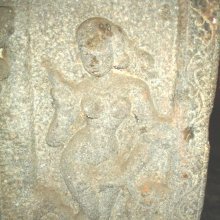Kataka, Kaṭaka: 35 definitions
Introduction:
Kataka means something in Buddhism, Pali, Hinduism, Sanskrit, Jainism, Prakrit, the history of ancient India, Marathi, Hindi, biology. If you want to know the exact meaning, history, etymology or English translation of this term then check out the descriptions on this page. Add your comment or reference to a book if you want to contribute to this summary article.
Alternative spellings of this word include Katak.
Images (photo gallery)
In Hinduism
Purana and Itihasa (epic history)
Source: Cologne Digital Sanskrit Dictionaries: The Purana Index1) Kaṭaka (कटक).—Viṣṇu.*
- * Viṣṇu-purāṇa IV. 15. 13.
2) Kataka (कतक).—A tribe conquered by Kalki.*
- * Brahmāṇḍa-purāṇa II. 31. 84.

The Purana (पुराण, purāṇas) refers to Sanskrit literature preserving ancient India’s vast cultural history, including historical legends, religious ceremonies, various arts and sciences. The eighteen mahapuranas total over 400,000 shlokas (metrical couplets) and date to at least several centuries BCE.
Natyashastra (theatrics and dramaturgy)
Source: Wisdom Library: Nāṭya-śāstraKaṭaka (कटक) refers to a kind of ornament (ābharaṇa) for the fingers (aṅguli) to be worn by males, according to Nāṭyaśāstra chapter 23. Such ornaments for males should be used in cases of gods and kings.
Kaṭaka (कटक) also refers to an ornament (ābharaṇa) for the fore-arm (bāhu) to be worn by females.
Kaṭaka (कटक) also refers to a type of ornament (ābharaṇa) for the ankles (gulpha) to be worn by females. Kaṭakas are hollow bangles within which small stone chips are lodged. Such ornaments for females should be used in cases of human females and celestial beings (gods and goddesses).
Ābharaṇa (‘ornaments’, eg., kaṭaka) is a category of alaṃkāra, or “decorations”, which in turn is a category of nepathya, or “costumes and make-up”, the perfection of which forms the main concern of the Āhāryābhinaya, or “extraneous representation”, a critical component for a successful dramatic play.

Natyashastra (नाट्यशास्त्र, nāṭyaśāstra) refers to both the ancient Indian tradition (shastra) of performing arts, (natya—theatrics, drama, dance, music), as well as the name of a Sanskrit work dealing with these subjects. It also teaches the rules for composing Dramatic plays (nataka), construction and performance of Theater, and Poetic works (kavya).
Ayurveda (science of life)
Nighantu (Synonyms and Characteristics of Drugs and technical terms)
Source: Wisdom Library: Raj NighantuKaṭaka (कटक) refers to the “middle part” of a mountain (giri) according to the second chapter (dharaṇyādi-varga) of the 13th-century Raj Nighantu or Rājanighaṇṭu (an Ayurvedic encyclopedia). The Dharaṇyādi-varga covers the lands, soil, mountains [viz., Kaṭaka], jungles and vegetation’s relations between trees and plants and substances, with their various kinds.
Kalpa (Formulas, Drug prescriptions and other Medicinal preparations)
Source: Shodhganga: Edition translation and critical study of yogasarasamgrahaKataka (कतक) refers to the medicinal plant known as “Strychnos potatorum Linn.” and is dealt with in the 15th-century Yogasārasaṅgraha (Yogasara-saṅgraha) by Vāsudeva: an unpublished Keralite work representing an Ayurvedic compendium of medicinal recipes. The Yogasārasaṃgraha [mentioning kataka] deals with entire recipes in the route of administration, and thus deals with the knowledge of pharmacy (bhaiṣajya-kalpanā) which is a branch of pharmacology (dravyaguṇa).
Toxicology (Study and Treatment of poison)
Source: Shodhganga: Kasyapa Samhita—Text on Visha ChikitsaKataka (कतक) is the name of an ingredient used in the treatment of Rājilā-snake-bites, according to the Kāśyapa Saṃhitā: an ancient Sanskrit text from the Pāñcarātra tradition dealing with both Tantra and Viṣacikitsā—an important topic from Āyurveda which deals with the study of Toxicology (Viṣavidyā or Sarpavidyā).—The tenth Adhyāya prescribes antidotes for Rājilā snake venom.—According to the Kāśyapasaṃhitā verse X.21-24: “A detailed fumigation regimen is prescribed to be administered for the snake-bite victim either in the afternoon, dusk or evening or at all the three times either individually or with the following multiple ingredients [like bark of Kataka] [...]”.

Āyurveda (आयुर्वेद, ayurveda) is a branch of Indian science dealing with medicine, herbalism, taxology, anatomy, surgery, alchemy and related topics. Traditional practice of Āyurveda in ancient India dates back to at least the first millenium BC. Literature is commonly written in Sanskrit using various poetic metres.
Shilpashastra (iconography)
Source: Shodhganga: The significance of the mūla-beras (śilpa)Kaṭaka (कटक) or Kaṭakahasta refers to “crab-hold” and represents one of the twenty-four gestures with a single hand, as defined according to texts dealing with śilpa (arts and crafs), known as śilpaśāstras.—Accordingly, pratimā-lakṣaṇa (body postures of the icons) is comprised of hand gestures (hasta, mudrā or kai-amaiti), stances/poses (āsanas) and inflexions of the body (bhaṅgas). There are thirty-two types of hands [viz., kaṭaka-hasta] classified into two major groups known as tolirkai (functional and expressive gestures) and elirkai (graceful posture of the hand).
Source: Shodhganga: Vaisnava Agamas And Visnu ImagesKaṭaka (कटक) refers to a “chain with link” and represents a type of “hand-ornaments” (hastabhūṣaṇa), as defined in treatises such as the Pāñcarātra, Pādmasaṃhitā and Vaikhānasa-āgamas, extensively dealing with the technical features of temple art, iconography and architecture in Vaishnavism.—There are a number of ornaments for hand and arms. According to Bharata, [viz., kalāpī (string of pearls), kaṭaka (chain with link ), śaṅkha (bracelet of conches), hastapatra (bracelet with design of creepers), pūraka (a flat bracelet) are the ornament for hand fist and upper part of wrist; and rings are meant for fingers].

Shilpashastra (शिल्पशास्त्र, śilpaśāstra) represents the ancient Indian science (shastra) of creative arts (shilpa) such as sculpture, iconography and painting. Closely related to Vastushastra (architecture), they often share the same literature.
Shaktism (Shakta philosophy)
Source: Google Books: ManthanabhairavatantramKaṭaka (कटक) refers to “(decorative) bangles”, according to the Kulakaulinīmata verse 3.77-81.—Accordingly, “Tvaritā is without compare and bestows all accomplishments. She is dark blue and her form is that of a (tribal) Śāvarī. She has big, upraised breasts and has two snakes as earrings and two as (her) anklets. She is the three-eyed goddess Tripurā who bestows boons and freedom from fear. Or else, she has eighteen arms and one should think (of her when engaged) in magical rites. She wears golden clothes and is adorned with a peacock banner. She sits on a lion throne, bestows boons and holds a peacock parasol. She has a peacock bangle [i.e., mayūra-kaṭaka-upetā] and is adorned with a garland of wild flowers. She is adorned with a beautiful peacock diadem”.
Source: Brill: Śaivism and the Tantric Traditions (shaktism)Kaṭaka (कटक) refers to “bracelets”, according to the King Vatsarāja’s Pūjāstuti called the Kāmasiddhistuti (also Vāmakeśvarīstuti), guiding one through the worship of the Goddess Nityā.—Accordingly, “[...] She has braided hair. Her limbs are adorned with bracelets (kaṭaka), earrings, necklaces, twining laces, girdles, jewels, and anklets. Her clothes resemble Bandhūka flowers. She is full of affection, and the hue of her body is brightened up with saffron and sandal paste.. [...]”.

Shakta (शाक्त, śākta) or Shaktism (śāktism) represents a tradition of Hinduism where the Goddess (Devi) is revered and worshipped. Shakta literature includes a range of scriptures, including various Agamas and Tantras, although its roots may be traced back to the Vedas.
Vastushastra (architecture)
Source: Brill: Śaivism and the Tantric Traditions (architecture)Kaṭaka (कटक) refers to an “armlet”, according to the Devyāmata (in the section śalyoddhāra-paṭala or “excavation of extraneous substances”).—Accordingly, “[...] If someone scratches his arm, there is armlet (kaṭaka) [at the depth] up to the arm. [That extraneous thing] exists [at a depth of] three and a half cubits [underground]. There is no doubt about it. If [someone] touches his [left?] hand, [the officiant] should prognosticate the leg of a couch [beneath the site]. If [someone] touches his finger, [the officiant] should know [that the extraneous thing] is situated at a depth up to the knee. [...]”.

Vastushastra (वास्तुशास्त्र, vāstuśāstra) refers to the ancient Indian science (shastra) of architecture (vastu), dealing with topics such architecture, sculpture, town-building, fort building and various other constructions. Vastu also deals with the philosophy of the architectural relation with the cosmic universe.
In Buddhism
Theravada (major branch of Buddhism)
Source: Pali Kanon: Pali Proper NamesA village in Ceylon granted by Aggabodhi IV. for the maintenance of the padhanaghara, which he built for the Elder Dathasiva. Cv.xlvi.12.
Theravāda is a major branch of Buddhism having the the Pali canon (tipitaka) as their canonical literature, which includes the vinaya-pitaka (monastic rules), the sutta-pitaka (Buddhist sermons) and the abhidhamma-pitaka (philosophy and psychology).
Tibetan Buddhism (Vajrayana or tantric Buddhism)
Source: MDPI Books: The Ocean of HeroesKaṭaka (कटक) refers to a “bracelet” (i.e., decoration for the hands), according to the 10th-century Ḍākārṇava-tantra: one of the last Tibetan Tantric scriptures belonging to the Buddhist Saṃvara tradition consisting of 51 chapters.—Accordingly: [while explaining the body circle (kāyacakra)]: “[...] The Yoginīs each are lofty and fleshy, adorned with a bracelet (kaṭaka) [on the hands] and have one lock of hair [on the head], replete with every [kind of good] characteristic, and are born of Vārāhī’s lineage. [...]”.

Tibetan Buddhism includes schools such as Nyingma, Kadampa, Kagyu and Gelug. Their primary canon of literature is divided in two broad categories: The Kangyur, which consists of Buddha’s words, and the Tengyur, which includes commentaries from various sources. Esotericism and tantra techniques (vajrayāna) are collected indepently.
In Jainism
Jain philosophy
Source: archive.org: Anekanta Jaya Pataka of Haribhadra SuriKaṭaka (कटक) (Sanskrit; in Prakrit: Kaḍaga) refers to a “bracelet”, as used in the Anekāntajayapatākā-prakaraṇa, a Śvetāmbara Jain philosophical work written by Haribhadra Sūri.—[Cf. Vol. I, P. 16, l. 9]—‘Kaḍaga’ (Sanskrit: ‘kaṭaka’) meaning a bracelet occurs in Nāyādhammakahā (I,1). ‘Kaṭaka’ occurs on p 318, L 22 of Anekāntajayapatākā. The word ‘kuṇḍala’ meaning ‘an ear ornament’ occurs in Viāhapannatti.
-
General definition (in Jainism)
Source: The University of Sydney: A study of the Twelve ReflectionsKaṭaka (कटक) refers to “armies”, according to the 11th century Jñānārṇava, a treatise on Jain Yoga in roughly 2200 Sanskrit verses composed by Śubhacandra.—Accordingly, “Connections with pleasing sense objects, whose impressions are full of deceit like dreams, perish immediately. Families, armies [com.—kaṭaka—‘armies’], empires, decorations and wealth are asserted by the great seers as acting like a series of clouds”.
Synonyms: Bala.

Jainism is an Indian religion of Dharma whose doctrine revolves around harmlessness (ahimsa) towards every living being. The two major branches (Digambara and Svetambara) of Jainism stimulate self-control (or, shramana, ‘self-reliance’) and spiritual development through a path of peace for the soul to progess to the ultimate goal.
India history and geography
Source: archive.org: Personal and geographical names in the Gupta inscriptionsKaṭaka (कटक) refers to a name-ending for place-names mentioned in the Gupta inscriptions (reigned from 3rd century CE). Kaṭaka is formed from the root √kaṭ to surround, to encompass, to cover and means a “royal camp”.
There is only one such place-name with the suffix “Kaṭaka”: Gupta inscription No. 29, L. 12, but the first part is not clearly legible. Sircar takes it to be bhrātṛ but does not seem to be correct as it yields nosense with the word Kaṭaka. The donated land is mentioned to have been given to the Chandoga (Sāmavedin) brāhmaṇa Varāha-svāmin, an inhabitant of this Kaṭaka.
Source: Cologne Digital Sanskrit Dictionaries: Indian Epigraphical GlossaryKaṭaka.—(EI 8, 17), the camp or capital. (SITI), a fortified place; a cantonment; a military camp. Cf. kaṭakaṃ kartavyam (LP), ‘an army should be sent [against one]’. Note: kaṭaka is defined in the “Indian epigraphical glossary” as it can be found on ancient inscriptions commonly written in Sanskrit, Prakrit or Dravidian languages.

The history of India traces the identification of countries, villages, towns and other regions of India, as well as mythology, zoology, royal dynasties, rulers, tribes, local festivities and traditions and regional languages. Ancient India enjoyed religious freedom and encourages the path of Dharma, a concept common to Buddhism, Hinduism, and Jainism.
Biology (plants and animals)
Source: Google Books: CRC World Dictionary (Regional names)1) Kataka in English is the name of a plant defined with Strychnos potatorum in various botanical sources. This page contains potential references in Ayurveda, modern medicine, and other folk traditions or local practices It has the synonym Strychnos heterodoxa Gilg (among others).
2) Kataka in India is also identified with Strychnos nux-vomica It has the synonym Strychnos spireana Dop (etc.).
Example references for further research on medicinal uses or toxicity (see latin names for full list):
· Lloydia (1973)
· E-Journal of Chemistry (2007)
· Rumphia (1836)
· Mémoires de la Société Botanique de France (1910)
· Botanische Jahrbücher für Systematik, Pflanzenge schichte und Pflanzengeographie (1893)
· Taxon (1980)
If you are looking for specific details regarding Kataka, for example health benefits, diet and recipes, pregnancy safety, chemical composition, extract dosage, side effects, have a look at these references.

This sections includes definitions from the five kingdoms of living things: Animals, Plants, Fungi, Protists and Monera. It will include both the official binomial nomenclature (scientific names usually in Latin) as well as regional spellings and variants.
Languages of India and abroad
Pali-English dictionary
Source: BuddhaSasana: Concise Pali-English Dictionarykaṭaka : (nt.) 1. a bracelet; 2. a rocky cave.
Source: Sutta: The Pali Text Society's Pali-English DictionaryKaṭaka, (m. nt.) anything circular, a ring, a wheel (thus in kara° Vin. II, 122); a bracelet PvA. 134. (Page 176)
— or —
Kataka, (nt.) (fr. kantati2) a scrubber, used after a bath Vin. II, 129, 143; cp. Vin. Texts II. 318. (Page 182)

Pali is the language of the Tipiṭaka, which is the sacred canon of Theravāda Buddhism and contains much of the Buddha’s speech. Closeley related to Sanskrit, both languages are used interchangeably between religions.
Marathi-English dictionary
Source: DDSA: The Molesworth Marathi and English Dictionarykaṭaka (कटक).—n S An army. Ex. ēkā praharānta vīsa kōsa || nalēṃ ka0 dūra vanīṃ || 2 A bracelet of gold, shell &c.
--- OR ---
kataka (कतक).—m S Clearing nut plant, Strychnos potatorum.
--- OR ---
kāṭaka (काटक).—m A description of people or an individual of it in the Carnatic, very savage and blood-thirsty. Hence applied to cut-throat people gen.
--- OR ---
kāṭaka (काटक).—a Hardy; the body: also hardworking--a person.
Source: DDSA: The Aryabhusan school dictionary, Marathi-Englishkaṭaka (कटक).—n An army. A bracelet of gold.
Marathi is an Indo-European language having over 70 million native speakers people in (predominantly) Maharashtra India. Marathi, like many other Indo-Aryan languages, evolved from early forms of Prakrit, which itself is a subset of Sanskrit, one of the most ancient languages of the world.
Sanskrit dictionary
Source: DDSA: The practical Sanskrit-English dictionaryKaṭaka (कटक).—1 A bracelet of gold; कटकाकृतिमुपमृद्य स्वस्तिकः क्रियन्ते (kaṭakākṛtimupamṛdya svastikaḥ kriyante) Mahābhārata on I.1.1. आबद्धहेमकटकां रहसि स्मरामि (ābaddhahemakaṭakāṃ rahasi smarāmi) Ch. P.15; Śiśupālavadha 16.77; कटकान्यूर्मिकाश्चापि चित्ररत्न- चयाङ्किताः (kaṭakānyūrmikāścāpi citraratna- cayāṅkitāḥ) Śiva. B.17.44.
2) A zone or girdle.
3) A string.
4) The link of a chain.
5) A mat.
6) seasalt.
7) The side or ridge of a mountain; प्रफुल्लवृक्षैः कटकैरिव स्वैः (praphullavṛkṣaiḥ kaṭakairiva svaiḥ) Kumārasambhava 7.52; R.16.31.
8) Table-land; स्फटिककटकभूमिर्नाटयत्येष शैलः (sphaṭikakaṭakabhūmirnāṭayatyeṣa śailaḥ) Śiśupālavadha 4.65.
9) An army, a camp; आकुल्यकारि कटकस्तुरगेण तूर्णम् (ākulyakāri kaṭakasturageṇa tūrṇam) Śiśupālavadha 5.59; Mu.5.
1) A royal capital or metropolis (rājadhānī).
11) A house or dwelling.
12) A circle or wheel.
13) A ring placed as an ornament upon an elephant's tusk.
14) Name of the capital of Orissa.
Derivable forms: kaṭakaḥ (कटकः), kaṭakam (कटकम्).
--- OR ---
Kataka (कतक).—[kaṃ jalaṃ śuddhaṃ tanoti tan -ḍa Tv.] The clearing-nut plant, (Mar. nivaḷī) (the nut of which is said to clear muddy water); फलं कतकवृक्षस्य यद्यप्यम्वु- प्रसादनम् । न नामग्रहणादेव तस्य वारि प्रसीदति (phalaṃ katakavṛkṣasya yadyapyamvu- prasādanam | na nāmagrahaṇādeva tasya vāri prasīdati) || Manusmṛti 6.67.
-tam, -takam The nut of this tree, see अम्बुप्रसादन (ambuprasādana) also.
Derivable forms: katakaḥ (कतकः).
See also (synonyms): kata.
Source: Cologne Digital Sanskrit Dictionaries: Edgerton Buddhist Hybrid Sanskrit DictionaryKaṭaka (कटक).—(nt.? compare -kāṭaka, for which Mahāvyutpatti Index suggests reading kaṭaka), a kind of fetter or bond, pre- sumably in form of a ring: Gaṇḍavyūha 353.12 (sattvān nānā-haḍi-)- nigaḍa-kaṭaka-kuṇḍala-(q.v.)-śrṅkhalā-khalīna-bandhana- baddhān.
--- OR ---
Kāṭaka (काटक).—(-kāṭaka), nt., in pātra-kāṭakam Mahāvyutpatti 8952, ring or which the almsbowl is fastened, = Tibetan lhuṅ gzed (bzed gzhag paḥi gdu bu, ring for putting almsbowl. [Boehtlingk and Roth] cite the passage with kaṭaka (as in Sanskrit and Pali), but Mironov also kā°; no v.l. in either ed. (but Index to Kyoto ed. cites both forms). However a form found with the same meaning in Divyāvadāna and Avadāna-śataka is -karaka or -kara, qq.v. On the other hand, Divyāvadāna likewise has a form kaṇṭaka, q.v., clearly meaning the same thing, which raises doubts as to the [etymology] Cf. kaṭaka.
Source: Cologne Digital Sanskrit Dictionaries: Shabda-Sagara Sanskrit-English DictionaryKaṭaka (कटक).—mn.
(-kaḥ-kaṃ) 1. The side or ridge of a hill or mountain. 2. Table land. 3. Sea-salt. 4. A ring placed as an ornament upon an elephant’s tusk. 5. A bracelet of gold, shell, &c. 6. A zone. 7. A royal metropolis. 8. A city or town. 9. A village. 10. A house or dwelling. 11. A camp. 12. An army. 13. A circle. 14. A wheel. E. kaṭa to encompass, kan Unadi aff.
--- OR ---
Kataka (कतक).—m.
(-kaḥ) The clearing nut plant, (Strychnos potatorum:) one of the seeds of this plant being rubbed upon the inside of the water jars used in Bengal, occasions a precipitation of the earthy particles diffused through the water.
Source: Cologne Digital Sanskrit Dictionaries: Benfey Sanskrit-English DictionaryKaṭaka (कटक).—m. and n. 1. A bracelet, [Kathāsaritsāgara, (ed. Brockhaus.)] 9, 73. 2. The hill of a mountain. 3. An army.
--- OR ---
Kataka (कतक).—m. The nut plant, Strychnos potatorum, which clears water, [Mānavadharmaśāstra] 6, 67.
Source: Cologne Digital Sanskrit Dictionaries: Cappeller Sanskrit-English DictionaryKaṭaka (कटक).—[masculine] a straw mat; [masculine] [neuter] cord, string, bracelet; valley; royal camp; caravan.
--- OR ---
Kataka (कतक).—[masculine] the Kataka tree; [neuter] the nut of it (used for clearing water).
Source: Cologne Digital Sanskrit Dictionaries: Aufrecht Catalogus Catalogorum1) Kataka (कतक) as mentioned in Aufrecht’s Catalogus Catalogorum:—See Vedāntakataka. Hall. p. 154.
2) Kataka (कतक):—Rāmāyaṇaṭīkā. Burnell. 178^b. Oppert. 1780. 1781. Ii, 7482. 7513. 7723. Often quoted by Rāma in his
—[commentary] on Rāmāyaṇa.
1) Kaṭaka (कटक):—[from kaṭ] m. (Comm. on [Uṇādi-sūtra ii, 32 and v, 35]) a twist of straw, a straw mat [commentator or commentary] on [Kātyāyana-śrauta-sūtra]
2) [v.s. ...] mn. a string, [Kādambarī]
3) [v.s. ...] a bracelet of gold or shell etc., [Śakuntalā; Mṛcchakaṭikā] etc.
4) [v.s. ...] a zone
5) [v.s. ...] the link of a chain
6) [v.s. ...] a ring serving for a bridle-bit, [Suśruta]
7) [v.s. ...] a ring placed as ornament upon an elephant’s tusk
8) [v.s. ...] the side or ridge of a hill or mountain
9) [v.s. ...] a valley, dale, [Raghuvaṃśa; Kathāsaritsāgara; Hitopadeśa]
10) [v.s. ...] a royal camp, [Kathāsaritsāgara; Hitopadeśa] etc.
11) [v.s. ...] an army, [cf. Lexicographers, esp. such as amarasiṃha, halāyudha, hemacandra, etc.]
12) [v.s. ...] a circle, wheel, [Horace H. Wilson]
13) [v.s. ...] a multitude, troop, caravan, [Daśakumāra-carita]
14) [v.s. ...] collection, compilation, [Kādambarī 40, 11]
15) [v.s. ...] sea-salt, [cf. Lexicographers, esp. such as amarasiṃha, halāyudha, hemacandra, etc.]
16) [v.s. ...] Name of the capital of the Orissa (Cuttack)
17) Kataka (कतक):—[from kata] m. Strychnos Potatorum or the clearing nut plant (its seeds rubbed upon the inside of water-jars precipitate the earthy particles in the water, [Horace H. Wilson]), [Manu-smṛti vi, 67; Suśruta]
18) [v.s. ...] Name of a commentator on the Rāmāyaṇa.
Source: Cologne Digital Sanskrit Dictionaries: Yates Sanskrit-English Dictionary1) Kaṭaka (कटक):—[(kaḥ-kaṃ)] 1. m. n. The side of a hill; a bracelet; a circle.
2) Kataka (कतक):—(kaḥ) 1. m. A nut plant which clears water (strychnos).
Source: DDSA: Paia-sadda-mahannavo; a comprehensive Prakrit Hindi dictionary (S)Kaṭaka (कटक) in the Sanskrit language is related to the Prakrit words: Kaḍaga, Kaḍaya, Kayaga.
[Sanskrit to German]
Sanskrit, also spelled संस्कृतम् (saṃskṛtam), is an ancient language of India commonly seen as the grandmother of the Indo-European language family (even English!). Closely allied with Prakrit and Pali, Sanskrit is more exhaustive in both grammar and terms and has the most extensive collection of literature in the world, greatly surpassing its sister-languages Greek and Latin.
Hindi dictionary
Source: DDSA: A practical Hindi-English dictionaryKaṭaka (कटक) [Also spelled katak]:—(nm) a cantonment; an army.
...
Kannada-English dictionary
Source: Alar: Kannada-English corpusKaṭaka (ಕಟಕ):—[noun] = ಕಟಕು [kataku]1.
--- OR ---
Kaṭaka (ಕಟಕ):—
1) [noun] any of numerous ten-footed crustaceans having the first pair of legs modified as pincers; a crab.
2) [noun] the zodiacal sign or constellation Cancer; the Crab.
--- OR ---
Kaṭaka (ಕಟಕ):—
1) [noun] a metal ornamental band or chain worn around the wrist; a bracelet.
2) [noun] a capital a city or town that is the official seat of government of a state; b) an important city where a certain industry, activity, etc. is centred.
3) [noun] the slope of a mountain.
4) [noun] the land by the side of a mountain.
5) [noun] a group of people; a multitude.
6) [noun] an organised military force armed for fighting esp. on land; an army.
7) [noun] the expanse of salt water that covers most of the earth’s surface and surrounds its land masses; a sea.
8) [noun] either of the two fleshy protuberances on the lower rear part of the human body; the posterior.
9) [noun] the state of being excessive; excessiveness; abundance.
10) [noun] a long pointed tooth, esp. protruding from a closed mouth, as in the elephant, walrus, etc.; a tusk.
11) [noun] an ornamental ring for the tusk of an elephant.
12) [noun] salt produced by evaporating sea water; sea-salt.
13) [noun] light, accompanied by heat, from the sun; sunlight.
14) [noun] the string of an archeṛs bow; a bow-string.
15) [noun] a large wasp, Vespa crabro, with a brown and yellow striped body, and capable of inflicting a severe sting; a hornet.
16) [noun] the capital city of erstwhile Orissa, a state in east India.
17) [noun] a circular frame or disc arranged to revolve on an axle and used to facilitate the motion of a vehicle or for various mechanical purposes; a wheel.
--- OR ---
Kaṭaka (ಕಟಕ):—[noun] the systematic and rhythmic pronunciation of the sounds of a percussion instrument used in Karnāṭaka music.
--- OR ---
Kataka (ಕತಕ):—[noun] 'the nut of the tree Strychnos potatorum (family: Loganiaceae); clearing nut, ued to clear the water of suspended dirt.'
--- OR ---
Kāṭaka (ಕಾಟಕ):—[noun] = ಕಾಟ [kata]1 (?).
--- OR ---
Kāṭaka (ಕಾಟಕ):—[noun] a man who annoys, inflicts troubles; a harasser.
--- OR ---
Kāṭaka (ಕಾಟಕ):—[noun] = ಕಾಟ [kata]2 - 2.
Kannada is a Dravidian language (as opposed to the Indo-European language family) mainly spoken in the southwestern region of India.
See also (Relevant definitions)
Starts with (+71): Kataka nuts, Kataka-adhiraja, Kataka-nayaka, Kataka-taka, Kataka-vardhana, Kataka-varika, Katakabija, Katakacankiranti, Katakacariya, Katakacarya, Katakaccakkaram, Katakadhi, Katakadhisha, Katakagriha, Katakah, Katakahasta, Katakai, Katakala, Katakali, Katakaloni.
Ends with (+40): Adrikataka, Ahikamtakataka, Ahikataka, Arikataka, Bhogikataka, Dhanakataka, Dhanyakataka, Ekataka, Garabhritkataka, Hakkataka, Hastakataka, Jalakataka, Kakkataka, Kalyanakataka, Kankataka, Karakataka, Karkataka, Katakataka, Katutkataka, Khandakataka.
Full-text (+285): Padakataka, Shailakataka, Katakam, Kayaga, Yupakataka, Astakatakam, Katakavaranasi, Katakiya, Katakavalayin, Katakagriha, Katakin, Kadaga, Toyaprasadana, Kadaya, Katakahasta, Vanikkataka, Samavasitakataka, Patrakaraka, Katakavaruttam, Ambuprasadana.
Relevant text
Search found 56 books and stories containing Kataka, Kaṭaka, Kāṭaka; (plurals include: Katakas, Kaṭakas, Kāṭakas). You can also click to the full overview containing English textual excerpts. Below are direct links for the most relevant articles:
Vinaya (3): The Cullavagga (by T. W. Rhys Davids)
Cullavagga, Khandaka 5, Chapter 22 < [Khandaka 5 - On the Daily Life of the Bhikkhus]
Cullavagga, Khandaka 5, Chapter 37 < [Khandaka 5 - On the Daily Life of the Bhikkhus]
Vastu-shastra (2): Town Planning (by D. N. Shukla)
The Markandeya Purana (Study) (by Chandamita Bhattacharya)
Types of Ornaments < [Chapter 2]
Cosmetics, Costumes and Ornaments in Ancient India (by Remadevi. O.)
2.5. Hand Ornaments (d): Kaṭaka < [Chapter 3 - Ornaments]
2.6. Various other Finger Ornaments < [Chapter 3 - Ornaments]
2.8. Various other Leg Ornaments < [Chapter 3 - Ornaments]
The history of Andhra country (1000 AD - 1500 AD) (by Yashoda Devi)
Part 39 - The Later Chalukyas of Srikurmam < [Chapter XI - The Chalukyas]
Part 12 - Alladanatha Devaraja and Bhimaraja (A.D. 1283) < [Chapter VI - The Parichchedis (A.D. 1040-1290)]
Part 14 - Later Kondapadumatis (A.D. 1252-1282) < [Chapter IV - The Kondapadumatis (A.D. 1100-1282)]
Related products







